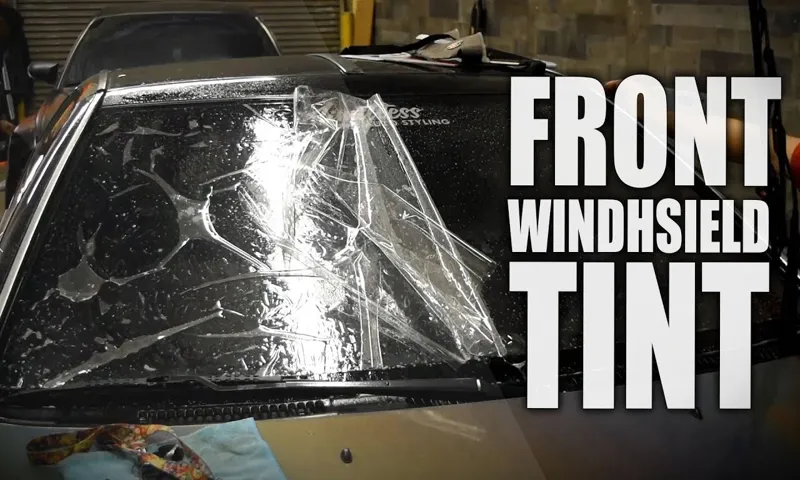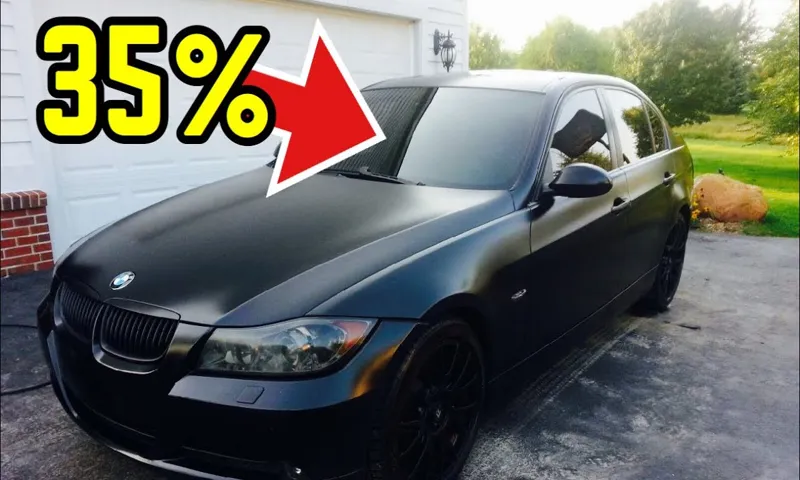Tinting your front windshield can make a significant difference in the overall driving experience. While some may think it’s just a cosmetic upgrade, it’s much more than that. Tinting can reduce glare, protect from harmful UV rays, increase privacy, and enhance the aesthetic appeal of your vehicle.
But before you go ahead and tint your windshield, there are a few things you need to know. First and foremost, it’s important to check your state’s laws and regulations regarding tinted windows. Each state has different laws, and some may restrict the level of tint allowed on the windshield.
Tinting also comes in different levels, from light tint to dark tint, and each has its own benefits and drawbacks. You’ll need to decide which level is right for you based on your preferences and driving needs. It’s also important to choose the right type of tint.
High-quality tint can last for years without fading or peeling, while low-quality tint can start to deteriorate after just a few months. And last but not least, it’s crucial to have a professional install your tint. DIY tinting may seem like an easy and cost-effective solution, but it can often result in uneven tint and air bubbles, leading to an unsightly appearance and reduced visibility.
Overall, tinting your front windshield can be a great investment in your driving experience, but it’s important to do your research and choose wisely. With the right tint and installation, you can enjoy the benefits of enhanced visibility, reduced glare, improved privacy, and protection from UV rays for years to come.
Table of Contents
Understanding Windshield Tinting
Many people wonder if they can tint the front windshield of their vehicle. The answer is, technically, yes. However, laws regarding front windshield tinting vary by state, and some states do not allow any tinting on the front windshield at all.
In addition to legal considerations, it’s important to choose the right type of tint film for your front windshield. High-quality tint films can reduce glare and heat, improve visibility, and protect your skin from harmful UV rays. However, low-quality tint films can actually make it more difficult to see the road and can lead to dangerous situations.
Make sure to do your research and consult with a professional before deciding to tint your front windshield.
Why Tint Your Front Windshield?
When it comes to tinting car windows, people often overlook the importance of tinting their front windshield. However, tinting your front windshield can bring many benefits, making it an essential part of car window tinting. First, it provides an extra layer of protection against harmful UV rays, which can damage your skin and eyes over time.
Additionally, it helps keep your car cooler by reducing the amount of heat that enters your car, making it more comfortable during hot days. Moreover, it reduces glare and improves visibility by reducing the amount of sunlight that enters your car, which can be especially helpful during sunrise or sunset. When it comes to the legal aspect, laws vary from one state to another, but it is generally permitted as long as it meets the criteria for light transmission.
Therefore, if you want to enhance your driving experience and protect yourself and your car, tinting your front windshield is definitely a smart choice.

Benefits of Tinting Your Front Windshield
If you’re considering tinting your front windshield, there are a few things you should know. First, windshield tinting involves adding a thin film of material to your windshield that helps to reduce glare and block harmful UV rays. This can make driving safer and more comfortable, especially if you live in a particularly sunny area or spend a lot of time on the road.
Some people also opt for windshield tinting for aesthetic reasons or to add an extra layer of privacy. However, it’s important to note that there are some legal restrictions around how dark your windshield tint can be, depending on where you live. Be sure to check with your local authorities before you invest in windshield tinting.
Overall, though, if you’re looking for a way to improve your driving experience, windshield tinting can be a great option.
Legal Considerations
If you’re wondering whether or not it’s legal to tint the front windshield of your car, the answer depends on the laws of your state. In some states, it’s completely legal to tint your front windshield, while in others, it’s not allowed at all. Additionally, there may be restrictions on the level of tint allowed on other windows of your car.
It’s important to research the specific laws in your state before tinting any windows on your vehicle. Failure to follow the laws can result in hefty fines, and in some cases, even having your car impounded. So, while tinting your front windshield may seem like a good idea for reducing glare and keeping your car cool, it’s crucial to make sure it’s legal in your state before doing so.
Laws on Front Windshield Tinting
When it comes to tinting the front windshield of your car, it’s important to be aware of the legal considerations in your area. Rules and regulations regarding front windshield tinting vary from state to state, with some authorities banning it altogether while others allow it to some degree. The purpose of these regulations is to ensure road safety and prevent accidents that might occur due to visibility issues caused by excessive tinting.
Before applying tint to your front windshield, make sure to check the specific laws in your area to avoid breaking any regulations. Don’t risk getting pulled over or facing fines by not being aware of the legal requirements. It’s essential to make informed decisions when making modifications to your vehicle to keep yourself and others safe on the road.
What Level of Tinting is Allowed?
When it comes to tinting your car windows, there are a few legal considerations to keep in mind. Each state has its own laws regarding the level of tint that is allowed, so it’s important to do your research before getting your windows tinted. In general, most states allow a certain percentage of visible light transmission (VLT) through the windows.
This means that a certain amount of light must be able to pass through the tinted glass so that drivers can have clear visibility while on the road. The maximum legal limit of VLT varies from state to state, but it is typically around 70%. Some states may also have specific regulations for the level of tint that is allowed on different windows of the car, such as the front windshield or the rear windshield.
So, before you invest in window tinting for your car, be sure to check with your state’s laws to ensure that you are compliant.
Consequences of Illegal Windshield Tinting
When it comes to windshield tinting, it’s important to know the legal considerations. There are consequences to illegal tinting, and it’s vital to understand them before making any decisions. In many states, having tinted windows that are too dark can result in a fine and possibly having to remove the tint.
Additionally, if you get into an accident, having illegal tinting can result in higher liability or even being held responsible for the accident. It’s important to research the laws in your state before making any decisions about tinting your windshield. Remember, breaking the law can have serious consequences, so it’s best to be informed and stay within the legal limits.
Choosing the Right Tinting
When it comes to tinting your car’s windows, many people are unclear about whether or not it’s legal to tint their front windshield. The short answer is yes, you can tint your front windshield, but there are restrictions on how dark the tint can be. In most states, the front windshield can only be tinted at the top, and the tinting must be no more than a few inches below the top of the windshield.
This is known as the “sun visor strip.” In addition to the restrictions on the amount of tinting on the front windshield, there may also be restrictions on the darkness of the tinting on other windows in your car. So, before you decide on the right tinting for your vehicle, be sure to check your local regulations to ensure you’re in compliance.
Whether you want to improve your car’s appearance, increase your privacy, or protect your interior from the sun’s harmful rays, there are many different types of window tints available to suit your needs. With the right tinting, you can enjoy all the benefits of a cooler, more comfortable ride, without sacrificing safety or breaking the law.
Types of Window Tinting
When it comes to choosing the right window tinting, there are a few different types to consider. The first is traditional dyed film, which is the most affordable option and provides some heat and UV protection. However, it doesn’t do as well in reducing glare or maintaining visibility.
Another option is metalized film, which is stronger and has more heat rejection, but can interfere with electronics and cell phone reception. Ceramic film is a newer option that offers high levels of heat and UV protection without interfering with electronics, but can be more expensive. The best option for you depends on your specific needs and preferences, so it’s important to do your research and consult with a professional.
Factors to Consider When Choosing Tinting
When choosing the right tinting for your car, there are several factors you need to keep in mind. First things first, think about why you want your car tinted, is it to reduce glare or for privacy? Once you determine the reason, consider the local laws and regulations on window tinting in your area. This will help you avoid getting fined or even worse, having to remove the tint altogether.
Additionally, think about the quality of the tinting. Cheap tinting may save you money upfront, but it may not last long and could result in bubbles, ripples, and discoloration. Finally, choose a tinting percentage that suits your needs.
If you want privacy, a higher percentage will work best, but if reducing glare is your priority, a lower percentage tint is ideal. Overall, these factors will help you choose the right tinting for your car that not only improves its appearance but also serves its intended purpose.
How to Choose a Professional Tinter
When it comes to choosing a professional tinter, it’s important to do your research and find the right fit for your needs. The first step is to check out their reviews and ratings online to get a sense of their previous work and customer satisfaction. It’s also crucial to inquire about their level of experience and expertise in the field, as well as the type of materials and equipment they use for tinting.
Additionally, don’t hesitate to ask for references from previous clients or to request a portfolio of their work. Whether you’re looking for automotive, residential or commercial tinting services, make sure to choose a professional tinter who can provide a high-quality job at a fair price. Remember, selecting the right tint can have significant effects on the appearance, health, and safety of your property or vehicle.
Alternatives to Front Windshield Tinting
Are you wondering if you can tint the front windshield of your car? While it may be tempting to add some extra shade to your front window, many states have laws that limit the level of tint that can be applied to the front windshield. However, there are some alternatives that can help reduce the amount of heat and glare entering your car without violating any laws. One solution is to use a sunshade, which can be placed in the front window when the car is parked.
Another option is to install UV-blocking film on the side windows or a visor strip on the top of the front windshield. Both options can provide some relief from the sun’s intense rays while also keeping you legal on the road. So if you’re looking to protect yourself and your car from the sun, consider these alternative options before tinting your front windshield.
Other Ways to Reduce Sun Glare and Heat in Your Car
If you’re not keen on tinting your front windshield, there are still a few things you can do to reduce sun glare and heat in your car. Consider getting a sunshade that fits your front windshield perfectly. This way, you can easily shade the front dashboard and steering wheel from direct sunlight.
Another alternative is to install window deflectors on the side windows. These can effectively reduce the amount of sunlight that enters the car through the side windows. Lastly, you can also get a dashboard cover that can protect your dashboard from sun damage and act as an extra shield from the sun’s rays.
These options may not provide the same level of sun protection as front windshield tinting, but they can still help improve your overall driving experience.
Comparing Front Windshield Tinting to Other Solutions
When considering alternative solutions to front windshield tinting, there are a few options available. One alternative is to use a reflective sunshade or visor that attaches to the windshield. These shades work by reflecting the sunlight away from the car, keeping the interior cooler and more comfortable.
However, they can be cumbersome to store and use, and they are not as effective as tinting in reducing UV radiation and protecting the interior of the car from fading. Another option is to use UV-blocking film, which can be applied to the windshield and other windows. This film prevents UV radiation from penetrating the glass, protecting the driver and passengers from harmful rays.
However, this film does not reduce heat and glare as effectively as tinting, and it may not be as durable as tinting over time. Overall, while there are alternatives to front windshield tinting, they may not provide the same level of protection and comfort as tinting does.
Conclusion
In conclusion, while you may be tempted to tint your front windshield to achieve that sleek, stylish look, it’s important to remember that safety should always come first. Illegal tinting can obstruct your view while driving, making you more prone to accidents and putting yourself and others in danger. So, take a pass on tinting your front windshield.
After all, true style and cleverness come from making responsible decisions and putting safety first.”
FAQs
What is windshield tinting?
Windshield tinting is the process of adding a thin film to the windshield to reduce the amount of sunlight and glare that enters the vehicle.
Can you tint the front windshield?
Yes, you can tint the front windshield to reduce the amount of sun glare and heat entering the vehicle. However, different states have different laws regarding the percentage of tint allowed on the front windshield.
Is windshield tinting safe?
Yes, windshield tinting is safe as long as it is done correctly. Ensuring that the tint is properly applied and doesn’t obstruct the driver’s vision is important for safe driving.
What are the benefits of windshield tinting?
Windshield tinting can reduce the amount of sun glare and heat that enters the vehicle, making it more comfortable for the driver and passengers. It can also protect the interior of the car from fading and damage caused by UV rays.
How long does windshield tinting last?
The lifespan of windshield tinting depends on the quality of the film and how well it is installed. High-quality tints can last up to 10 years, while lower-quality tints may need to be replaced within a few years.
Can I tint my windshield myself?
It is not recommended to tint your windshield yourself. Proper installation requires special tools and expertise to ensure that the tint is applied correctly and does not obstruct the driver’s vision.
Will windshield tinting affect my visibility at night?
Properly installed windshield tinting should not significantly affect visibility at night. However, darker tints may decrease visibility in low-light conditions, so it’s important to choose the appropriate level of tint for your needs.



